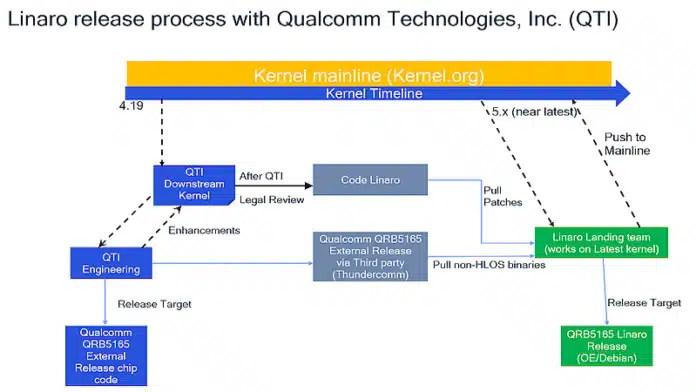- The next-gen Robotics RB5 platform, experience intuitive voice-activated robots and explore the prowess of the Cloud AI 100 product.
- Open source is changing how industries work and bringing in new improvements.
The open-source development model paves the way for technical advancements, especially among Linux developers focusing on kernel and driver solutions. Qualcomm Technologies, Inc. (QTI) has embraced open-source development, leveraging features and updates from the Linux community, allowing contributors to display their solutions prominently.
Central to the open-source strategy is its collaboration with Linaro, the organisation responsible for overseeing open-source software tailored for the Arm instruction set architecture. The company’s role is pivotal in standardising software solutions for Arm architectures, which are now embedded in many devices. This partnership ensures that hardware and software advancements are consistent, driving pivotal innovations in the sector.
Leading IoT Innovation and Advancing Technologies
An example of the company’s open-source contributions is its Robotics RB5 platform. This platform is at the forefront of the Internet of Things (IoT), offering high-speed connectivity and precise AI/ML inferencing. It accelerates the development of robots and drones tailored for various applications, ranging from enterprises to professional services. Furthering technological progress, their voice-activated robots now offer a more intuitive interaction method, responding dynamically to voice commands. Their platform also powers image recognition robots, enabling them to navigate and interact based on visual cues. It involves a robot integrated with the Qualcomm platform, adeptly detecting and grasping objects like a paper cup.
Ensuring innovation, the team behind the Development Kit commits to upstreaming Linux enhancements, maintaining alignment with the evolving mainline Linux kernel. Their Cloud AI 100 product is designed for cloud-based inferences like image classification and natural language processing. This product’s release emphasizes the Direct Rendering Manager (DRM) accelerator driver, supporting multiple Linux distributions.
The rise of open-source software development as a dominant method is clear. It promotes technological advancement, especially in robotics, and fosters trust and flexibility. Companies can leverage transparent, adaptable software solutions through partnerships like these, streamlining their processes and potentially reducing costs.










































































